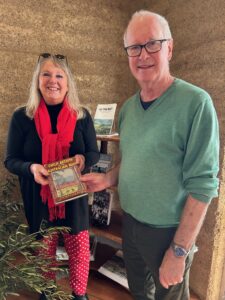On 30 August 2024, I had the privilege of repatriating a copy of the book Child Artists of the Australian Bush, written by Mary Durack Miller and Florence Rutter and published in 1952, about the Aboriginal child artists of Carrolup.
My friend and colleague at the South Australian Museum, Lea Gardham, has a volunteer working with her, Dianne Osborne, who spotted this copy of the book while volunteering at a local bookshop. She wanted to get it back to Community, and Lea contacted me. This all took place just over a fortnight ago.
I suggested, immediately, that The Kodja Place at Kojonup, located about 265 km south-east of Perth, would be an appropriate repository. I checked with my good friend Lisa Martello Hart, who has worked closely with The Kodja Place over several years, and she confirmed that KP (as we call it) did not have a copy of its own.
 So, Lea put the book in the mail the very next day, knowing that I was planning a trip down south and—amazingly for Australia Post—the package arrived just three days later! It all worked out very nicely.
So, Lea put the book in the mail the very next day, knowing that I was planning a trip down south and—amazingly for Australia Post—the package arrived just three days later! It all worked out very nicely.
When I visited KP, people were in the throes of finalising the re-design of a gallery for their forthcoming exhibition, which celebrates the legacy of Bella Kelly RIP, who was such an important Noongar artist. They were also carrying the artworks into the building for display. So everybody was very busy!
With all of this going on— friends and volunteers being focussed on ‘manning the ship’—we were still able to arrange a simple ‘gifting’ of the book to KP. Lisa took a photo of both Jill Watkin, Manager of KP, and myself, for both Diane and Lea, and for all of you.
Isn’t it wonderful that somebody, who we didn’t know, from so far away, in Adelaide, spotted this copy of the book that brought the Aboriginal child artists (they were not all Noongar) into the spotlight of the world, way back in the late 1940s and the very beginning of the 1950s?
Sadly, Carrolup was closed at the end of 1950. The Story of Carrolup was short-lived, and yet it lives on, still.


